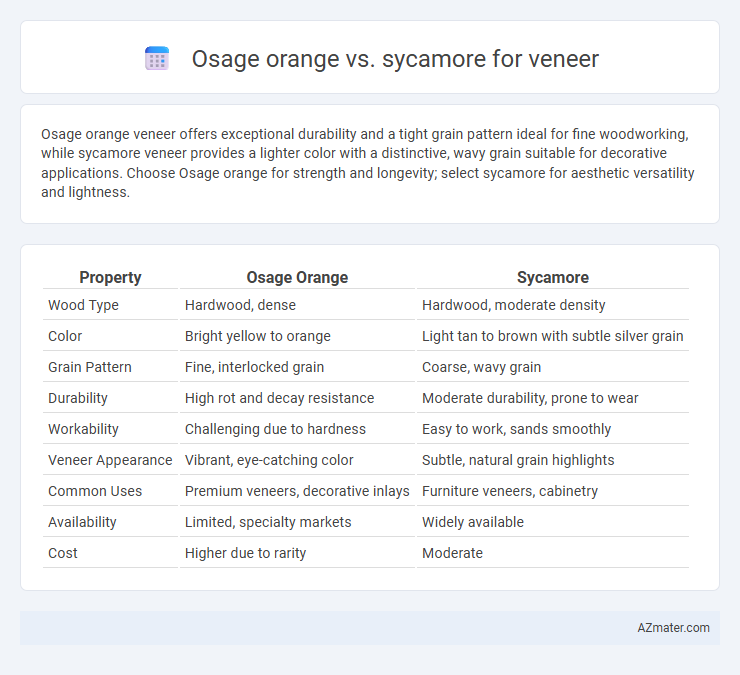Osage orange veneer offers exceptional durability and a tight grain pattern ideal for fine woodworking, while sycamore veneer provides a lighter color with a distinctive, wavy grain suitable for decorative applications. Choose Osage orange for strength and longevity; select sycamore for aesthetic versatility and lightness.
Table of Comparison
| Property | Osage Orange | Sycamore |
|---|---|---|
| Wood Type | Hardwood, dense | Hardwood, moderate density |
| Color | Bright yellow to orange | Light tan to brown with subtle silver grain |
| Grain Pattern | Fine, interlocked grain | Coarse, wavy grain |
| Durability | High rot and decay resistance | Moderate durability, prone to wear |
| Workability | Challenging due to hardness | Easy to work, sands smoothly |
| Veneer Appearance | Vibrant, eye-catching color | Subtle, natural grain highlights |
| Common Uses | Premium veneers, decorative inlays | Furniture veneers, cabinetry |
| Availability | Limited, specialty markets | Widely available |
| Cost | Higher due to rarity | Moderate |
Introduction to Osage Orange and Sycamore Veneer
Osage Orange veneer is prized for its vibrant yellow-orange hue and exceptional hardness, making it ideal for decorative panels and high-end furniture. Sycamore veneer features a pale, creamy color with distinctive mottled or burl patterns, valued for its smooth texture and visual appeal in cabinetry and interior designs. Both veneers offer durability and unique grain characteristics, catering to diverse aesthetic preferences in wood veneer applications.
Botanical Profiles and Origins
Osage orange (Maclura pomifera) is a hardwood native to the south-central United States, recognized for its dense, fine-grained texture and vibrant yellow-orange coloration, making it prized for decorative veneer applications. Sycamore (Platanus occidentalis), indigenous to eastern North America, features a lighter, blotchy grain pattern with a creamy to light brown hue, commonly used for its uniform texture and dimensional stability in veneers. Both species contribute unique botanical and aesthetic qualities to veneer production, with Osage orange offering greater hardness and color intensity, while Sycamore provides a distinctive figure and lighter tone.
Grain Pattern and Visual Appeal
Osage orange veneer is prized for its fine, interlocking grain pattern that creates a dense, textured surface with striking, natural variations, offering a warm yellow to orange-haired appearance that deepens with age. Sycamore veneer exhibits a more pronounced, wavy grain with bold, irregular curls and flashes, providing a lighter, cream to pale brown coloration that enhances visual depth and complexity. Both woods are valued for decorative applications, but Osage orange delivers a more uniform, vibrant character while sycamore provides dynamic figure and a softer, intricate aesthetic.
Color Characteristics and Aging
Osage orange veneer exhibits a vibrant yellow-orange hue that deepens to a rich golden brown with age, offering striking warmth and natural luster. Sycamore veneer features a pale cream to light brown color with subtle gray undertones that mellow into a soft amber, enhancing its refined and elegant appearance over time. Both woods develop patinas that highlight grain patterns, but Osage orange maintains a more vivid color retention compared to Sycamore's gentle color transformation.
Workability and Machinability
Osage orange veneer offers exceptional workability with a fine, uniform grain that responds well to cutting and sanding, producing a smooth finish ideal for detailed woodworking projects. Sycamore veneer, while generally easy to machine, tends to have a more open grain structure that can cause slight fuzziness during sanding and may require additional finishing steps. Both veneers machine efficiently, but Osage orange's denser, harder composition demands sharper tools and slower feed rates for optimal results.
Durability and Stability
Osage orange veneer exhibits exceptional durability due to its high resistance to decay and insect damage, making it ideal for long-lasting applications. Sycamore veneer, while moderately durable, tends to absorb moisture more readily, which can compromise stability over time. The dense, tightly-grained structure of Osage orange ensures superior dimensional stability compared to the more porous and softer Sycamore wood.
Cost Comparison and Availability
Osage orange veneer typically commands a higher price due to its rarity and unique grain patterns, whereas sycamore veneer is more affordable and widely available across North America, making it a cost-effective choice for large projects. Sycamore's consistent supply from sustainable sources allows for steady pricing, whereas Osage orange's limited availability can result in price volatility and longer lead times. Choosing between the two depends on budget constraints and desired aesthetic, with sycamore offering better cost efficiency and Osage orange presenting premium exclusivity.
Environmental Impact and Sustainability
Osage orange veneer is prized for its durability and dense grain, offering longer-lasting products that reduce the need for frequent replacement and thus lower environmental impact. Sycamore veneer, harvested from fast-growing trees, supports sustainable forestry practices by promoting rapid regeneration and carbon sequestration. Both species contribute to environmentally responsible veneer production, but Osage orange's longevity and Sycamore's renewability highlight distinct sustainability advantages.
Best Use Cases for Each Veneer
Osage orange veneer excels in high-end furniture and decorative paneling due to its vibrant yellow-orange hues and exceptional durability, making it ideal for visually striking applications that require strength. Sycamore veneer offers a lighter, more uniform grain with subtle figuring, making it perfect for modern interior cabinetry and architectural millwork where a clean, elegant appearance is desired. Both veneers perform well in environments demanding aesthetic appeal and structural integrity, with Osage orange suited for bold design statements and Sycamore favored for refined, contemporary finishes.
Choosing the Right Veneer: Osage Orange or Sycamore?
Osage Orange veneer offers exceptional durability and a rich, vibrant yellow-green hue that darkens with age, making it ideal for bold, long-lasting furniture and decorative panels. Sycamore veneer features a lighter, creamy color with distinctive wavy grain patterns, providing a elegant, subtle texture suited for refined interior designs. Selecting between Osage Orange and Sycamore veneers depends on desired aesthetic impact and wood hardness, with Osage Orange excelling in robustness and Sycamore favored for sophisticated visual appeal.

Infographic: Osage orange vs Sycamore for Veneer
 azmater.com
azmater.com